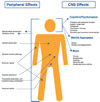Therapeutic perspectives for the treatment of Huntington's disease: treating the whole body
- PMID: 17999380
- PMCID: PMC2657556
- DOI: 10.14670/HH-23.237
Therapeutic perspectives for the treatment of Huntington's disease: treating the whole body
Abstract
Huntington's disease (HD) is a tremendously debilitating disorder that strikes relatively young individuals and progresses rapidly over the next ten to fifteen years inducing a loss of cognitive and motor skills and eventually death occurs. The primary locus of the disorder is a polyglutamine expansion of the protein product of the huntingtin (htt) gene. The htt protein appears to be a scaffolding protein that orchestrates the complex assembly of multiple intracellular proteins involved in multiple processes, including vesicular movement and cell metabolism. The htt protein is ubiquitously expressed in human tissues but the predominance of the interest in the pathology lies in its effects on the central nervous system (CNS). Most of the current therapeutics for HD thus have been targeted at preventing neuronal damage in the CNS, however, a considerable body of evidence has been accumulating to suggest that the maintenance of a healthy nervous system is tightly linked with peripheral physiological health. Therefore treatment of both the peripheral and central pathophysiologies of HD could form the basis of a more effective HD therapeutic strategy.
Figures

Similar articles
-
Striatal expression of a calmodulin fragment improved motor function, weight loss, and neuropathology in the R6/2 mouse model of Huntington's disease.J Neurosci. 2009 Sep 16;29(37):11550-9. doi: 10.1523/JNEUROSCI.3307-09.2009. J Neurosci. 2009. PMID: 19759302 Free PMC article.
-
Novel BAC Mouse Model of Huntington's Disease with 225 CAG Repeats Exhibits an Early Widespread and Stable Degenerative Phenotype.J Huntingtons Dis. 2015;4(1):17-36. J Huntingtons Dis. 2015. PMID: 26333255 Free PMC article.
-
Treating the whole body in Huntington's disease.Lancet Neurol. 2015 Nov;14(11):1135-42. doi: 10.1016/S1474-4422(15)00177-5. Lancet Neurol. 2015. PMID: 26466780 Review.
-
Protective Effects of Antioxidants in Huntington's Disease: an Extensive Review.Neurotox Res. 2019 Apr;35(3):739-774. doi: 10.1007/s12640-018-9989-9. Epub 2019 Jan 11. Neurotox Res. 2019. PMID: 30632085 Review.
-
Huntington's disease: the current state of research with peripheral tissues.Exp Neurol. 2009 Oct;219(2):385-97. doi: 10.1016/j.expneurol.2009.05.012. Epub 2009 May 19. Exp Neurol. 2009. PMID: 19460373 Review.
Cited by
-
Possible involvement of self-defense mechanisms in the preferential vulnerability of the striatum in Huntington's disease.Front Cell Neurosci. 2014 Sep 26;8:295. doi: 10.3389/fncel.2014.00295. eCollection 2014. Front Cell Neurosci. 2014. PMID: 25309327 Free PMC article. Review.
-
Ghrelin receptor signaling: a promising therapeutic target for metabolic syndrome and cognitive dysfunction.CNS Neurol Disord Drug Targets. 2010 Nov;9(5):557-63. doi: 10.2174/187152710793361513. CNS Neurol Disord Drug Targets. 2010. PMID: 20632971 Free PMC article. Review.
-
Reprogramming Huntington monkey skin cells into pluripotent stem cells.Cell Reprogram. 2010 Oct;12(5):509-17. doi: 10.1089/cell.2010.0019. Cell Reprogram. 2010. PMID: 20936902 Free PMC article.
-
Polyglutamine toxicity in non-neuronal cells.Cell Res. 2010 Apr;20(4):400-7. doi: 10.1038/cr.2010.32. Epub 2010 Mar 16. Cell Res. 2010. PMID: 20231860 Free PMC article. Review.
-
Allosteric modulators of g protein-coupled receptors: future therapeutics for complex physiological disorders.J Pharmacol Exp Ther. 2009 Nov;331(2):340-8. doi: 10.1124/jpet.109.156380. Epub 2009 Aug 10. J Pharmacol Exp Ther. 2009. PMID: 19667132 Free PMC article. Review.
References
-
- Anden NE, Dalen P, Johansson B. Baclofen and lithium in Huntington’s chorea. Lancet. 1973;2:93. - PubMed
-
- Andrich J, Saft C, Gerlach M, Schneider B, Arz A, Kuhn W, Muller T. Coenzyme Q10 serum levels in Huntington’s disease. J. Neural Transm. Suppl. 2004;68:111–116. - PubMed
-
- Arenas J, Campos Y, Ribacoba R, Martin MA, Rubio JC, Ablanedo P, Cabello A. Complex I defect in muscle from patients with Huntington’s disease. Ann. Neurol. 1998;43:397–400. - PubMed
-
- Bachoud-Levi AC, Gaura V, Brugieres P, Lefaucheur JP, Boisse MF, Maison P, Baudic S, Ribeiro MJ, Bourdet C, Remy P, Remy P, Cesaro P, Hantraye P, Peschanski M. Effect of fetal neural transplants in patients with Huntington’s disease 6 years after surgery: a long-term follow-up study. Lancet Neurol. 2006;5:303–309. - PubMed
-
- Barker RA, Rosser AE. Neural transplantation therapies for Parkinson’s and Huntington’s diseases. Drug Discov. Today. 2001;6:575–582. - PubMed
Publication types
MeSH terms
Substances
Grants and funding
LinkOut - more resources
Full Text Sources
Other Literature Sources
Medical
